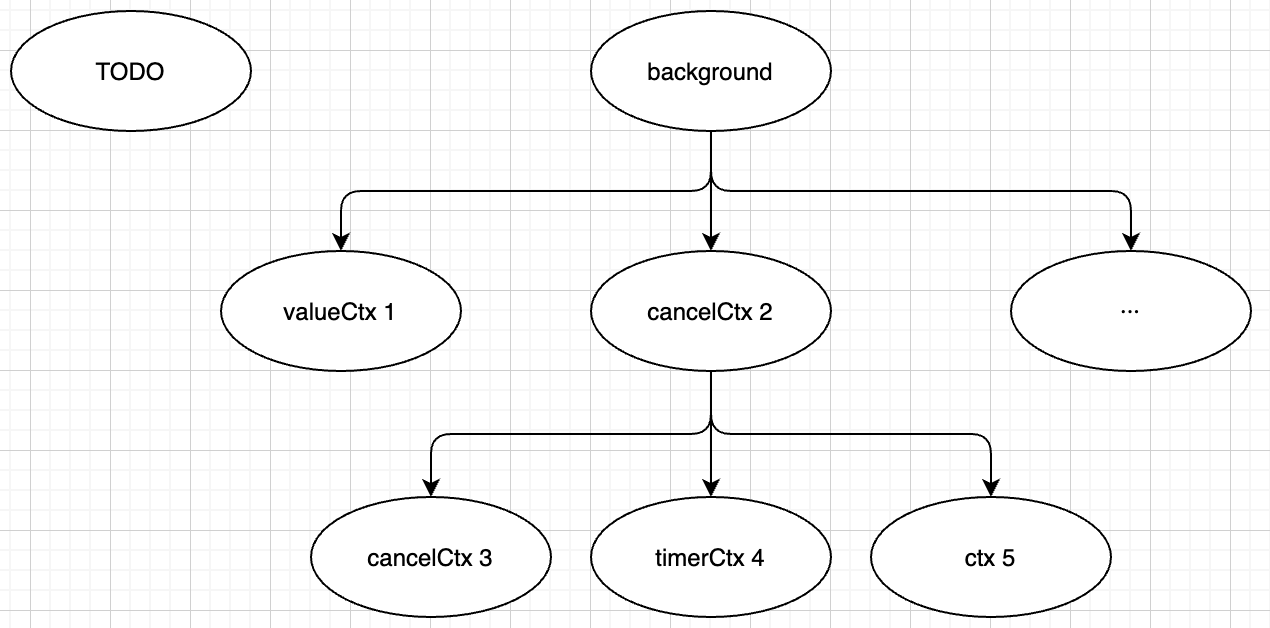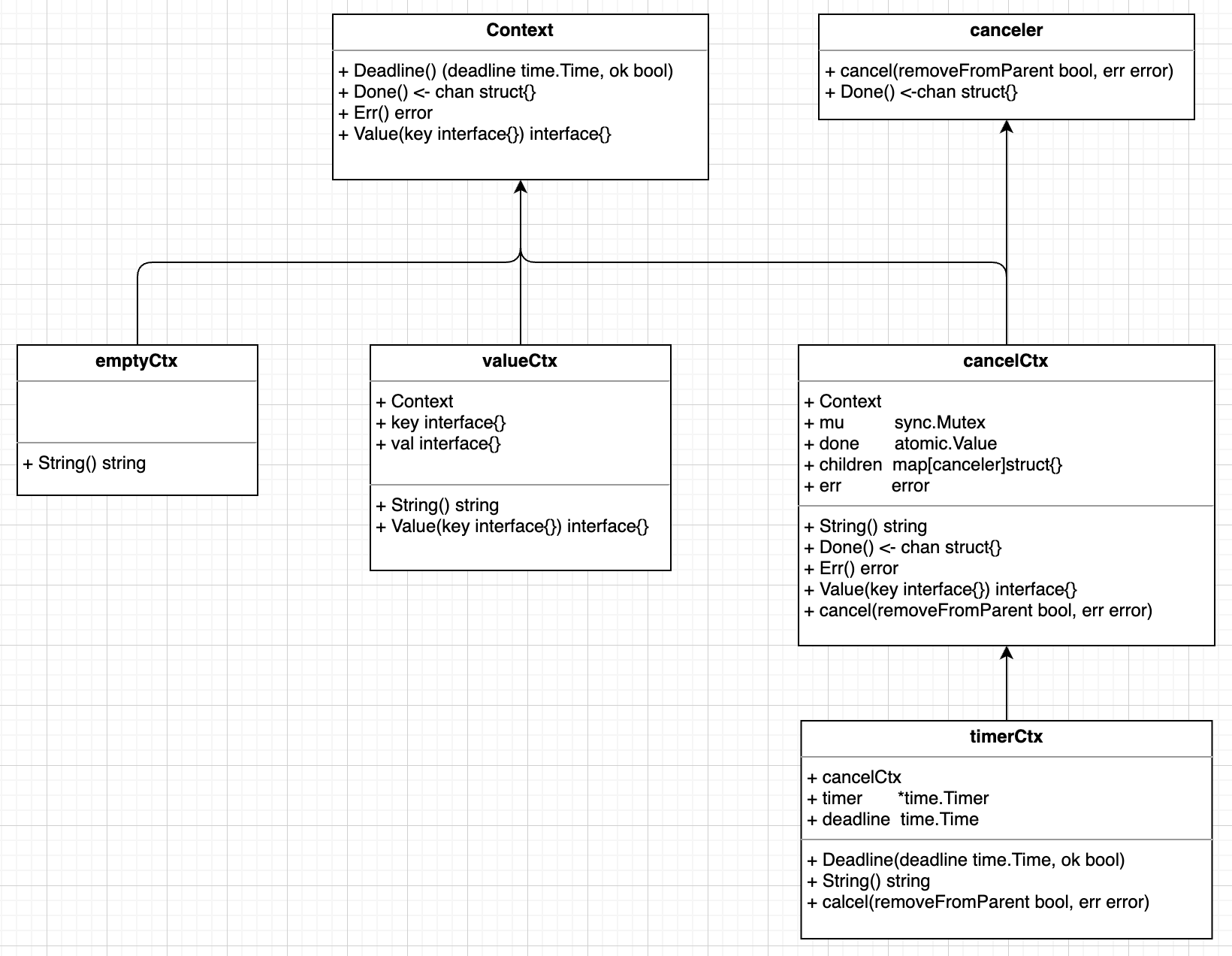概述
Go 1.7 标准库引入 Context,用于传递上下文信息,如取消信号、超时信号、k-v 键值对等
源码解析
分析基于 go 1.17.5 版本的代码
整体概览
首先,代码中定义了两个 ctx background、TODO,他们作为所有 ctx 的根。所有的 ctx 组成树状的结构,如下图

树中父节点 ctx 取消则会使其所有子节点取消,例如 cancelCtx 2 取消,则 cancelCtx3、timerCtx4、ctx 5 均会被取消
在源码文件中,主要有如下的 interface 与 struct,以下是它们间的关系

其中 Context interface 指明编写一个 context 应实现哪些方法;而 canceler 是用于实现可取消的 context 的,例如下面的 cancelCtx 和 timerCtx
而基于这两个 interface,实现了如下四个 struct。
emptyCtx
emptyCtx,顾名思义就是空的 ctx。从代码中也可以看出,Deadlint、Done 等方法的实现中无任何逻辑,就是一个空壳子。
这里有个细节:emptyCtx struct 事实上是 int 类型的。因为 background 和 todo 两个变量均为 emptyCtx 类型的,因此不能将 emptyCtx 定义为 struct{} 类型
仅对外暴露 Background、TODO 方法,用于获取 ctx 树的根节点。
1
2
3
4
5
6
7
8
9
10
11
12
13
14
15
16
17
18
19
20
21
22
23
|
type emptyCtx int
func (*emptyCtx) Deadline() (deadline time.Time, ok bool) {return}
func (*emptyCtx) Done() <-chan struct{} {return nil}
func (*emptyCtx) Err() error {return nil}
func (*emptyCtx) Value(key interface{}) interface{} {return nil}
func (e *emptyCtx) String() string {
switch e {
case background:
return "context.Background"
case todo:
return "context.TODO"
}
return "unknown empty Context"
}
var (
background = new(emptyCtx)
todo = new(emptyCtx)
)
func Background() Context {return background}
func TODO() Context {return todo}
|
cancelCtx
代码有些多,拆成两部分来说。
首先是 cancelCtx 的 struct 定义。mu 字段用户保证 done、children、err 字段的读写原子性;done 字段记录该 cancelCtx 是否被取消;children 记录基于其衍生出的 context,即其后代 ctx。
1
2
3
4
5
6
7
8
|
type cancelCtx struct {
Context
mu sync.Mutex // protects following fields
done atomic.Value // of chan struct{}, created lazily, closed by first cancel call
children map[canceler]struct{} // set to nil by the first cancel call
err error // set to non-nil by the first cancel call
}
|
然后是 cancelCtx 各方法的实现
1
2
3
4
5
6
7
8
9
10
11
12
13
14
15
16
17
18
19
20
21
22
23
24
25
26
27
28
29
30
31
32
33
34
35
36
37
38
39
40
41
42
43
44
45
46
47
48
49
50
51
52
53
54
55
56
57
58
59
60
61
62
63
64
65
66
67
68
69
70
71
72
73
74
75
76
77
78
79
80
81
82
83
84
85
86
87
88
89
90
91
92
93
94
95
|
var cancelCtxKey int
// context 的 value 的获取是遍历 ctx 树的过程。如果当前 context 的 key 对不上,则检查父节点的 key。
func (c *cancelCtx) Value(key interface{}) interface{} {
// 如果 key 为 cancelCtxKey ,则返回自身
// 这是一段特殊逻辑,为了便于找最近的 cancelCtx
if key == &cancelCtxKey {
return c
}
return c.Context.Value(key)
}
// 返回 c.done 的值
func (c *cancelCtx) Done() <-chan struct{} {
// 这里用了 Load 原子读,所以不需要加锁
d := c.done.Load()
if d != nil {
return d.(chan struct{})
}
c.mu.Lock()
defer c.mu.Unlock()
d = c.done.Load()
if d == nil {
d = make(chan struct{})
c.done.Store(d)
}
return d.(chan struct{})
}
func (c *cancelCtx) Err() error {
// 上锁防止读时被其它 goroutine 写,从而导致数据不一致
c.mu.Lock()
err := c.err
c.mu.Unlock()
return err
}
type stringer interface {
String() string
}
func contextName(c Context) string {
if s, ok := c.(stringer); ok {
return s.String()
}
return reflectlite.TypeOf(c).String()
}
func (c *cancelCtx) String() string {
return contextName(c.Context) + ".WithCancel"
}
func (c *cancelCtx) cancel(removeFromParent bool, err error) {
if err == nil {
panic("context: internal error: missing cancel error")
}
c.mu.Lock()
if c.err != nil {
c.mu.Unlock()
return // 当前 ctx 已被取消
}
// 取消当前 ctx,同时取消其子 ctx
c.err = err
d, _ := c.done.Load().(chan struct{})
if d == nil {
c.done.Store(closedchan)
} else {
close(d)
}
for child := range c.children {
// NOTE: acquiring the child's lock while holding parent's lock.
child.cancel(false, err)
}
c.children = nil
c.mu.Unlock()
// 是否将当前 ctx 从父 ctx 的 children 列表中移除
if removeFromParent {
removeChild(c.Context, c)
}
}
// removeChild removes a context from its parent.
func removeChild(parent Context, child canceler) {
p, ok := parentCancelCtx(parent)
if !ok {
return
}
p.mu.Lock()
if p.children != nil {
delete(p.children, child)
}
p.mu.Unlock()
}
|
接下来看看 WithCancel 方法,即生成 cancelCtx 的方法
1
2
3
4
5
6
7
8
9
10
11
12
13
14
15
|
func WithCancel(parent Context) (ctx Context, cancel CancelFunc) {
if parent == nil {
panic("cannot create context from nil parent")
}
// 以 parent 为父 ctx,创建子 ctx
c := newCancelCtx(parent)
// 根据 parent ctx 状态判断子 ctx 是否应该取消
propagateCancel(parent, &c)
return &c, func() { c.cancel(true, Canceled) }
}
// newCancelCtx returns an initialized cancelCtx.
func newCancelCtx(parent Context) cancelCtx {
return cancelCtx{Context: parent}
}
|
其中的 propagateCancel 方法比较复杂,单独拎出来仔细瞧瞧
1
2
3
4
5
6
7
8
9
10
11
12
13
14
15
16
17
18
19
20
21
22
23
24
25
26
27
28
29
30
31
32
33
34
35
36
37
38
39
40
41
42
43
44
45
46
47
48
49
50
51
52
53
54
55
56
57
58
59
60
61
62
63
64
65
66
67
68
69
70
71
72
|
// goroutines counts the number of goroutines ever created; for testing.
var goroutines int32
// propagateCancel arranges for child to be canceled when parent is.
// propagateCancel 保证了当父 ctx 取消时,子 ctx 也会被取消
func propagateCancel(parent Context, child canceler) {
done := parent.Done()
if done == nil {
return // 父 ctx 未被取消
}
// 若父 ctx 已取消,则新创建的子 ctx 直接取消
select {
case <-done:
// parent is already canceled
child.cancel(false, parent.Err())
return
default:
}
if p, ok := parentCancelCtx(parent); ok {
// 如果 parent 为 cancelCtx,则其有 children 字段
p.mu.Lock()
if p.err != nil {
// parent has already been canceled
child.cancel(false, p.err)
} else {
if p.children == nil {
p.children = make(map[canceler]struct{})
}
p.children[child] = struct{}{}
}
p.mu.Unlock()
} else {
// 如果 parent 不为 cancelCtx,则其无 children 字段,不能通过遍历 children 的方式取消子 ctx(方法cancelCtx.cancel)
// 只能通过启 goroutine 的方式,每个 goroutine 监听 parent.Done 然后关闭 children
atomic.AddInt32(&goroutines, +1)
go func() {
select {
case <-parent.Done():
child.cancel(false, parent.Err())
case <-child.Done():
}
}()
}
}
// &cancelCtxKey is the key that a cancelCtx returns itself for.
var cancelCtxKey int
// parentCancelCtx returns the underlying *cancelCtx for parent.
// It does this by looking up parent.Value(&cancelCtxKey) to find
// the innermost enclosing *cancelCtx and then checking whether
// parent.Done() matches that *cancelCtx. (If not, the *cancelCtx
// has been wrapped in a custom implementation providing a
// different done channel, in which case we should not bypass it.)
// 判断 parent 是否为 cancelCtx 或者其子类
func parentCancelCtx(parent Context) (*cancelCtx, bool) {
done := parent.Done()
if done == closedchan || done == nil {
return nil, false
}
p, ok := parent.Value(&cancelCtxKey).(*cancelCtx)
if !ok {
return nil, false
}
pdone, _ := p.done.Load().(chan struct{})
if pdone != done {
return nil, false
}
return p, true
}
|
timerCtx
timerCtx 源码相对简单,是在 cancelCtx 的基础上,增加了过期时间控制
1
2
3
4
5
6
7
8
9
10
11
12
13
14
15
16
17
18
19
20
21
22
23
24
25
26
27
28
29
30
|
type timerCtx struct {
cancelCtx
timer *time.Timer // Under cancelCtx.mu.
deadline time.Time
}
func (c *timerCtx) Deadline() (deadline time.Time, ok bool) {
return c.deadline, true
}
func (c *timerCtx) String() string {
return contextName(c.cancelCtx.Context) + ".WithDeadline(" +
c.deadline.String() + " [" +
time.Until(c.deadline).String() + "])"
}
func (c *timerCtx) cancel(removeFromParent bool, err error) {
c.cancelCtx.cancel(false, err)
if removeFromParent {
// Remove this timerCtx from its parent cancelCtx's children.
removeChild(c.cancelCtx.Context, c)
}
c.mu.Lock()
if c.timer != nil {
c.timer.Stop()
c.timer = nil
}
c.mu.Unlock()
}
|
创建 timerCtx 时候,有不少对过期时间的判断
1
2
3
4
5
6
7
8
9
10
11
12
13
14
15
16
17
18
19
20
21
22
23
24
25
26
27
28
29
30
|
func WithDeadline(parent Context, d time.Time) (Context, CancelFunc) {
if parent == nil {
panic("cannot create context from nil parent")
}
// 如果父节点的过期时间比子节点过期时间早,则相当于子节点的过期取消逻辑不会被触发,因此这里直接返回 cancelCtx
if cur, ok := parent.Deadline(); ok && cur.Before(d) {
// The current deadline is already sooner than the new one.
return WithCancel(parent)
}
c := &timerCtx{
cancelCtx: newCancelCtx(parent),
deadline: d,
}
propagateCancel(parent, c)
dur := time.Until(d)
// 如果 deadline 时间已到
if dur <= 0 {
c.cancel(true, DeadlineExceeded) // deadline has already passed
return c, func() { c.cancel(false, Canceled) }
}
c.mu.Lock()
defer c.mu.Unlock()
if c.err == nil {
// 设置过期触发的事件
c.timer = time.AfterFunc(dur, func() {
c.cancel(true, DeadlineExceeded)
})
}
return c, func() { c.cancel(true, Canceled) }
}
|
valueCtx
逻辑比较清楚明了,因此只看一下 Value 方法。Value 的逻辑是在 ctx 树中回溯遍历 key,一直遍历到满足条件为止。
1
2
3
4
5
6
7
8
9
10
11
|
type valueCtx struct {
Context
key, val interface{}
}
func (c *valueCtx) Value(key interface{}) interface{} {
if c.key == key {
return c.val
}
return c.Context.Value(key)
}
|
思考
valueCtx
context 中获取 value 值是通过逐个遍历 key,找到对应的 value 的。相比于 map 查找性能低不少;并且我理解 context 应该是用作上下文状态同步的,value 方法感觉有点多余
cancelCtx
cancelCtx.mu 是普通的互斥锁而不是读写锁。个人理解 context 是读多写少的场景,因此使用读写锁可能开销更大。
参考资料
https://zhuanlan.zhihu.com/p/110085652
https://zhuanlan.zhihu.com/p/68792989
https://zhuanlan.zhihu.com/p/163684835
https://lailin.xyz/post/go-training-week3-context.html


